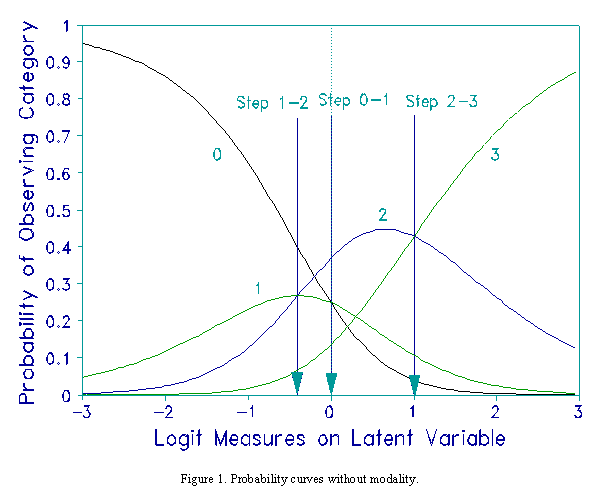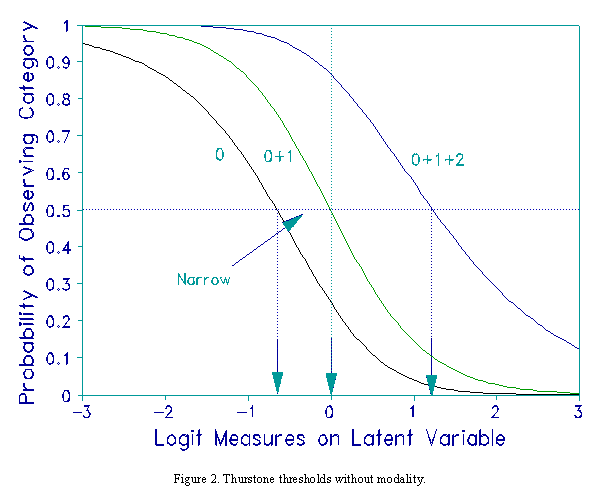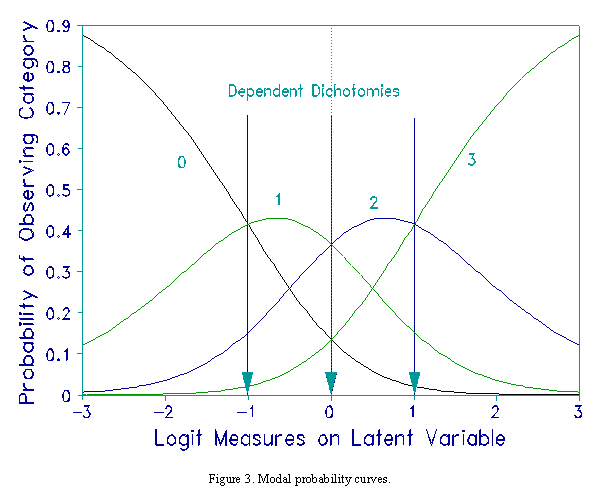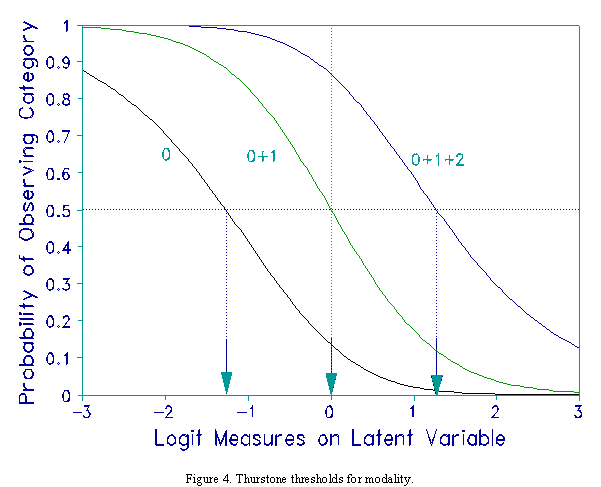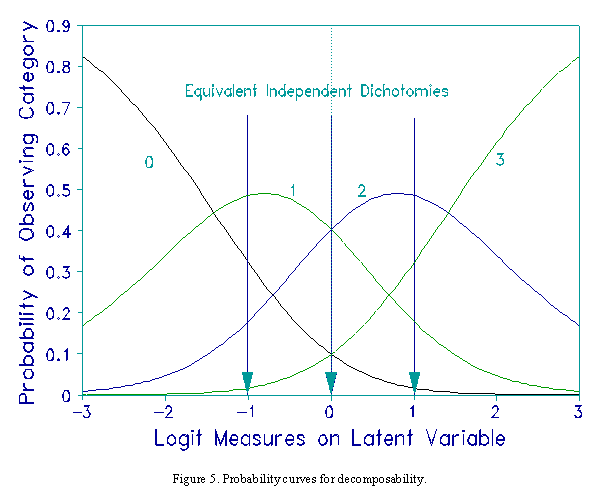Rating Scales, Disordering and Inferential Falsification
Andrich (1996) implies there are three levels of inferential validity inherent in a Rasch rating scale model: linearity,
modality and decomposability.
1. Linearity without Decomposability
The construction of linear measures from ordinal data requires models resembling:

where Pni...k is the probability that category k is observed when person n of ability Bn encounters item i of difficulty
Di. "..." represents other components of the measurement situation which intervene additively.
Fk is the difficulty of being observed in category k relative to category k-1, i.e., the step from category k-1 to
category k. Fk corresponds to the position on the latent variable, relative to the item difficulty, at which categories
k-1 and k are equally probable.
The estimate of Fk is dominated by the logarithm of the relative frequencies of the occurrence of categories k-1 and
k in the data. Accordingly Fk may take any value from - to +. The derivation of a Rasch Rating Scale model
from the standpoint of the measures implied by paired comparisons imposes no constraint on the {Fk} apart from
that required for identifiability, which is conventionally Fk=0.
For usefully linear measures to be obtained from ordinal data, the data must approximate this model or one of
similar form. The success of the approximation can be assessed by standard statistical techniques. In practice,
however, "something is better than nothing", so the measures from even poorly fitting data are employed in
preference to using raw scores or simply abandoning inference.
When Fk+1 is less than Fk, then the implication is that it is more likely that a higher category will be observed than
the adjacent lower one, all else being equal. This is termed disordering. "... there is nothing ... that constrains
[Rasch-Andrich] threshold estimates to be ordered ..." (Andrich, p. 20, his italics). Figure 1 illustrates this in terms of category
probabilities. F2, the step from category 1 to category 2 is less than F1, the step from category 0 to category 1.
Consequently category 1 is never a most likely, i.e., a modal, category.
Disordering occurs because a category maps onto only a narrow interval on the latent variable. Figure 2 illustrates
this in terms of Rasch-Thurstone thresholds. Category 1 is seen to occupy a rather narrow interval of the latent variable.
2. Modality or Dependent Decomposability
Andrich (p. 20) suggests "One hypothesis is that the [Rasch-Andrich] thresholds are ordered correctly." Correctly here means that the
{Fk} have strictly ascending values. The implication of strict ascension is that each category in turn becomes modal
on the latent variable. This is illustrated by the probability curves in Figure 3, in which the probability curves can
be thought of as a "range of hills". Successive modality of categories has the inferential advantage that advances
along the latent variable correspond strictly with advance in the category that is most likely to be observed.
This facilitates communication and representation of the latent variable in terms of categories observed.
When modality is obtained, the categories can also be conceptualized as ordered dependent dichotomies. The
dichotomies are located at the {Fk} and exhibit Guttman behavior, i.e., being observed in category k implies success
on the kth and all earlier dichotomies. Figures 3 and 4 illustrate modality.
Andrich (p. 17) terms failure of the rating scale categories to exhibit successive modality as "falsification of the
ordering of the categories". Of course, this is not a falsification of the substantive ordering of the categories, but on
their failure to be ordered modally and so be representable as ordered dependent dichotomies. For instance, category
1, Disagree, may be rarely used on a particular survey, and so never modal on the scale "0=Strongly Disagree,
1=Disagree, 2=Agree, 3=Strongly Agree". Thus it is reported that the "ordering of the categories is falsified". This
does not mean that Disagree implies more disagreement than Strongly Disagree, or more agreement than Agree. It
merely implies that Disagree is rarely observed and so corresponds to a narrow interval on the latent variable.
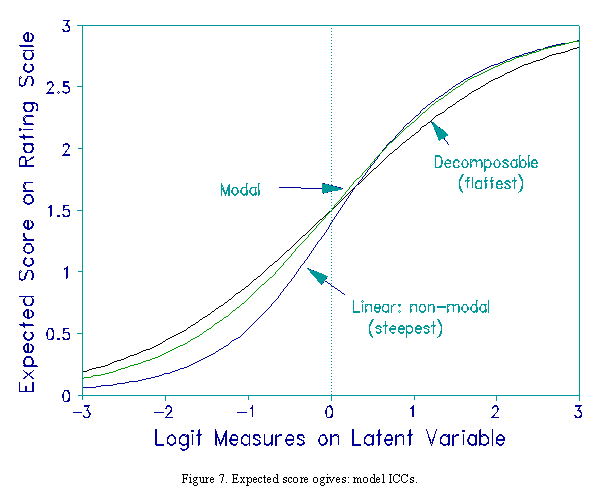
3. Independent Decomposability
Andrich (p. 17) suggests the possibility of an even stricter criterion, that the rating scale be conceptualized as
"independent dichotomous decisions". If a rating scale can be decomposed mathematically into independent
dichotomies, then each dichotomous decision point can be identified with a conceptually independent location on
the variable, further simplifying communication. This occurs transparently when a raw score on a multiple-choice
test is treated as an ordinal category on a rating scale corresponding to the length of the test.
The mathematical requirements for a rating scale to be decomposable into dichotomies are complex (Huynh 1996),
but, for practical purposes, unless each Fk is at least 1.4 logits greater than its predecessor, the rating scale is not
decomposable. Figures 4 and 5 illustrate a decomposable rating scale.
Andrich DA (1996) Measurement criteria for choosing among models with graded responses. Chapter 1 in A. von
Eye & C.C. Clogg, Categorical Variables in Developmental Research. San Diego: Academic Press.
Huynh H (1996) Decomposition of a Rasch partial credit item ... Psychometrika 61:1 31-39.


